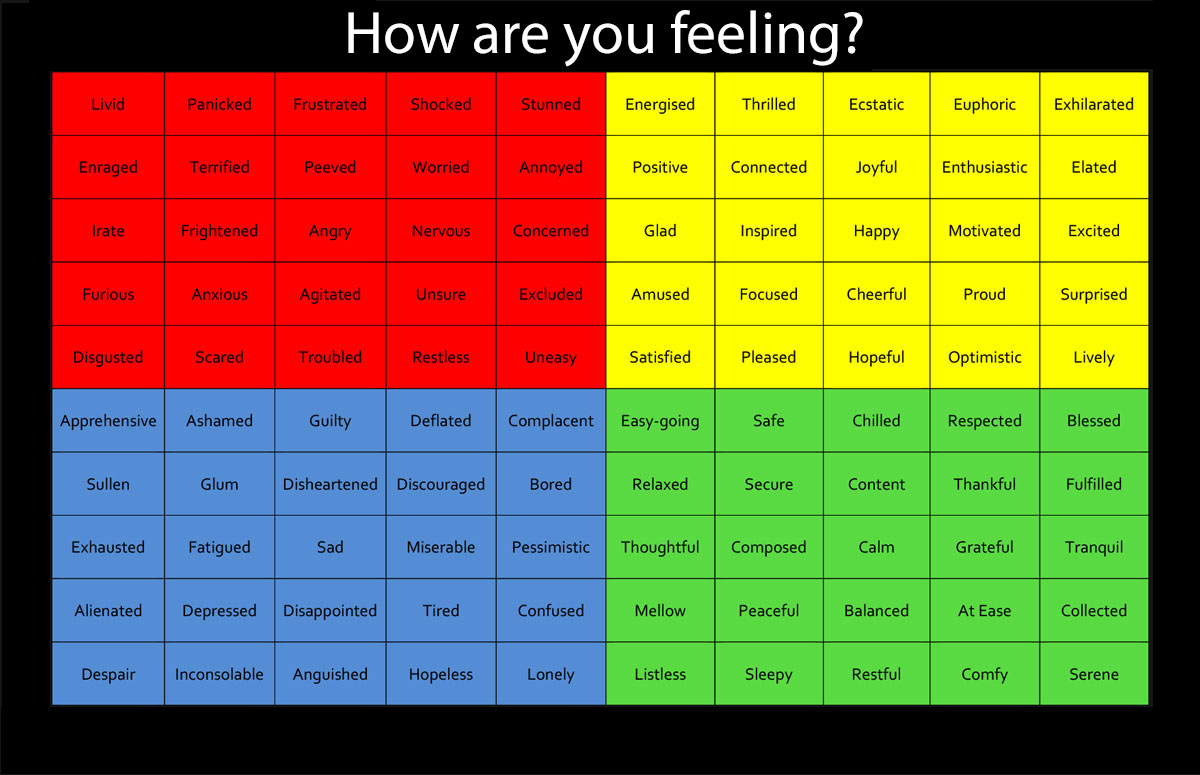Labeling and Expressing Emotions- Permission to Feel

Labeling Emotions
There is a known theory that there is a vocabulary gap between rich and lower income families. However, that gap fades when it comes to the words we use to describe our feelings. So many words can be used to describe our feelings, yet we normally only choose one or two. We normal say fine, good, busy, and so on. Without proper vocabulary we cannot label our emotions, therefore without the proper label we can't truly consider them or put them into perspective. We regulate our emotions by being able to recognize, understand, and labeling the proper emotions, by truly focusing on where we are on the mood meter to better determine where or what we are truly feeling.

Each mood on the mood meter requires a different approach when handling emotions. In order to know what approach is needed we must be able to label the correct emotion. Labeling emotions help us connect recognition and understanding to expression and regulation. We need to help our students develop a deeper vocabulary when it comes to labeling and identifying their feelings. Without truly knowing how you feel there isn't a way to help our students overcome the emotion and continue on. By labeling emotions correctly we open the door to complete four things according to Marc Brackett.
We are able to:
1. legitimizes and organizes feelings, which gives emotions substance which we can compare.
2. Helps others meet our needs, others are able to look beyond behavior to determine causes.
3. Helps meet the needs of others and
4. Connects us to rest of the world.
The more students are able to label and describe what they feel, the greater the chance they will receive empathy and be able to access the help they need in order to navigate through those feelings. Labeling the correct emotion is key to addressing the emotion and arriving at a resolution. Being able to recognize, understand, and label feelings allows for students to be able to make a change.
Expressing Emotions
In
my previous post I reflected on the importance of Recognizing, Understanding,
and Labeling emotions. As, important as those components are they are also
happening eternally in most cases. The last two stages are moving into the
ability to express and regulate emotions.
In order for students to safely be able to express their emotions, they must know they will be heard, accepted, there will not be judgement, they need to know they will receive the support they need. For most students, this can be a scary stage, there is so much unknown. We need to ensure that our own emotions are in check before we help another student express their own. We want to make sure we are reacting properly and appropriately to whatever they may feel. When students don't feel safe to express themselves their emotions continue to stay bottled up inside. In turn, that may cause self-doubt, low self-esteem, and loneliness. Students need to know that their feelings are valid whether they are positive or negative emotions.
In today's society there are many unspoken rules when it comes to emotions. Many times, we share only the positive, we talk to the people closest to us, and we put on a brave face in fear of rejection or looking weak. Children pick up on these nuances and learn to follow these unspoken rules. However, this holds everyone back from truly expressing their emotions.
As adults, parents, and educators the key concept we need to be mindful of when children are expressing their emotions is to truly listen. Actively listening with our whole body. We are sending a huge message to children that we see them, hear them, and are here for them. We also need to be mindful of cultural, gender, and racial aspects of emotions. For example, men are "tough, protectors of the family", it's "acceptable" for women to cry, some cultures make eye contact while others show respect by not making eye contact. Understanding these differences allow use to be emotional scientist. We are able to see help students to truly recognize, understand, label, and express emotions.
References:
Permission to Feel: Unlocking the Power of Emotions to Help Our Kids, Ourselves, and Our Society Thrive by Mark Brackett Ph.D.